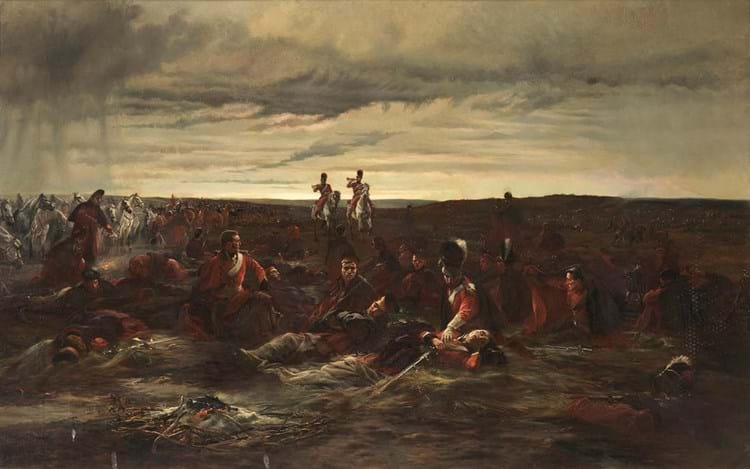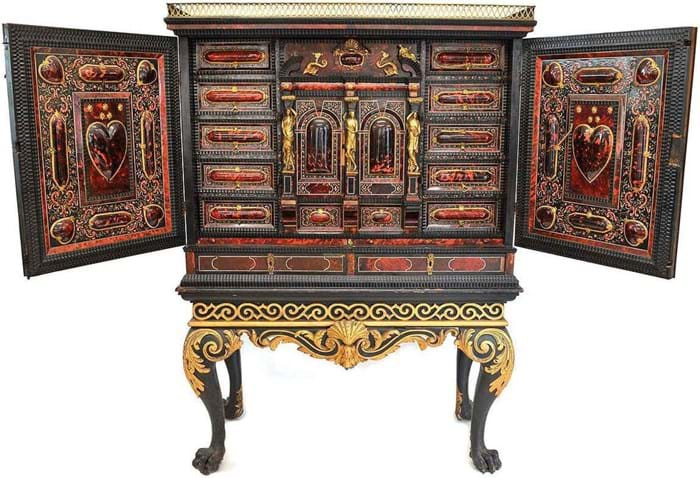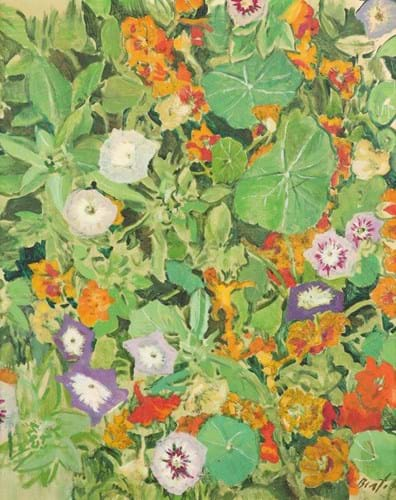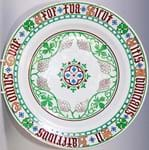
Dawn of Waterloo, The Reveille in the Bivouac of the Scots Greys on the Morning of the Battle by Lady Elizabeth Butler has been acquired by London’s National Army Museum.
In the Art Fund 2021/22 annual report, it revealed how its grants had led to acquisitions for many of the 800-plus museums in its network.
The acquisitions are funded by the 130,000 members who buy the National Art Pass alongside the generosity of trusts, foundations and donors.
The report said: “We were very pleased to see an increase in applications for acquisitions in 2021, after an understandably quieter time in 2020.”
Saving Lady Butler’s Waterloo
At the time that Dawn of Waterloo, The Reveille in the Bivouac of the Scots Greys on the Morning of the Battle was painted in 1895 it was highly unusual for one reason.
Battlefield art was almost exclusively a male field and this 4ft 2in x 6ft 5in (1.27m x 1.96m) oil on canvas was created by a woman – Lady Elizabeth Butler (1846-1933). Married to a senior army officer, she went on to become one of the foremost painters of battle scenes appealing both to popular patriotic sentiment and to critics such as Ruskin, who said she had forced him to admit he had been wrong in believing that ‘no woman could paint’.
The painting is one of a series of works sold recently at auctions and by dealers that have been bought by UK museums and galleries with the help of Art Fund support.
Dawn of Waterloo… has been acquired by London’s National Army Museum (NAM) for a total cost of £214,800, including an Art Fund grant of £135,320. The work had passed by direct descent from Lady Butler (nee El i zabeth Southerden Thompson) to the Falkland Stewardship Trust charity. It was auctioned at the Napoleon Bonaparte: The British Sale held by Bonhams in London in October last year when it sold for £260,000 (£325,250 with buyer’s premium).
NAM holds preliminary sketches for Dawn of Waterloo…, giving an insight into the way Butler worked up the painting, first at her home in Co Wicklow and then when she and her husband moved to Aldershot.
Horses at the Front
Another NAM purchase is a First World War work by Algernon Talmage (1871-1939): Wounded Horses Returning from the Front, France. The 2ft 6in x 3ft 11in (76cm x 1.08m) oil on canvas dated from 1918.
Sold by the Chris Beetles gallery, the total cost was given as £31,500 with a £9450 grant from Art Fund. It had featured in the gallery’s June to July 2021 exhibition.
Talmage, an official war artist, was commissioned by the Canadian War Memorials Fund and attached to the Canadian Army Veterinary Corps. This work shows a mobile unit set up to give first aid to horses. It may be the original painting of the subject exhibited at the Royal Academy in 1919 before Talmage completed the larger version of the work that now hangs in the Canadian State Chamber in Ottawa.
Return to Norton
A Flemish cabinet, c.1635-40 has been bought by Norton Priory Museum & Gardens in Runcorn, Cheshire (which opened in 1982). Art Fund provided a grant of £13,420 towards a total cost given as £26,840.
As indicated on labels verso, it was once owned by Sir Robert Brooke and was part of the furnishings of Norton Priory – the family seat. In 1920, the year before the Brooke family left the house (it was partially demolished in 1928), a massive auction was held at the 30-bedroom property over five days.
Many locals bought items, including the farming family that later chose to part with the 4ft 4in (1.32m) cabinet and its later English rococo base at the Wilson55 auction in Nantwich held in July last year. It sold for £22,000 (plus premium) against a guide of £5000-10,000.
Beaton’s cuttings
Society photographer Cecil Beaton (1904-80) was also a skilled painter, gardener and flower arranger. An oil on canvas by him, Cutting Garden Flowers, c.1960-65, has been bought by The Garden Museum in London. The total cost was £12,900, including an Art Fund grant of £3152.
The 22 x 18in (56 x 46cm) work had sold at Salisbury auction house Woolley & Wallis for £10,000 (plus premium), 10 times the low estimate, in May last year.
Cumbrian Towne
A Francis Towne (1739-1816) watercolour and pen and ink on paper view of the Lakes has been acquired by Armitt Library and Museum in Ambleside, Cumbria. The total cost was given as £10,400 including an Art Fund grant of £2600.
The 10½ x 15in (26.5 x 38cm) work had originally been offered at the auction titled Oakley House, The Collection of Eustace Gibbs, 3rd Baron Wraxall, held by Dreweatts in May 2019, where it made £8000 (plus premium).
Cornish Hunt
Falmouth Art Gallery has acquired The Lizard, Cornwall, a 8 x 10½in (20 x 26cm), watercolour and pencil on paper by William Holman Hunt (1827-1910) which sold at Sotheby’s in London in July last year for £15,000 (plus premium). It will feature in the gallery’s touring exhibition The Legend of King Arthur: A Pre- Raphaelite Love Story, from this October to September 2023.
The total cost was given as £18,900 by the Art Fund, including a £7450 grant. The Art Fund said it had been owned by Holman Hunt’s family by descent.
Leach and Blake
A Bernard Leach (1887-1979) slipware dish worked with a bird and an inscription after William Blake, joins the holdings of the Crafts Study Centre (CSC) in Farnham, Surrey. The collection there includes the pots, papers, photographs, diaries and drawings that Leach gifted to the centre himself. This 8in (20cm) dish from 1917 had been inherited by Janet Leach on her husband’s death in 1979, and it was eventually sold from Henry Rothschild’s ground-breaking Primavera Gal lery in Cambridge. It took a premium-inclusive £11,340 at the auction titled The Art of Fire: selections from the Dr John P Driscoll Collection held by Phillips in association with Maak in November last year.
The total cost was given as £12,618 including an Art Fund grant of £5009.
In October 2018 CSC bought an archive of letters by Leach at saleroom Lawrences of Crewkerne for £3400. Consigned for sale by his adopted son Maurice Leach, the letters – about 35 in total – were written by Bernard to Laurie Cookes, who became his second wife, in 1934-35 while spending a year in Japan.
Saving Cleopatra

Henri de Triqueti’s sculpture The Death of Cleopatra has been bought by the Victoria and Albert Museum.
Henri de Triqueti’s (1803-74) The Death of Cleopatra, an ivory and bronze sculpture on a marble and ebony base with traces of polychrome and gilding, 15 x 20 x 9½in (38 x 51 x 24.5cm), has been bought by the Victoria and Albert Museum.
The 1859 work had originally been sold at auction by Bamfords of Derby for £22,000 (plus buyer’s premium) in January 2019 against a guide of £2000-3000 (see ATG No 2382). It had been bought by a dealer who later negotiated a sale overseas.
In December 2020 it was subject to a temporary export ban from the UK. The Art Fund gave the total cost of the latest purchase at £150,000, including a grant of £40,000.
Claudel at the Burrell
The Burrell Collection in Glasgow has become the first public UK collection to acquire a work by sculptor Camille Claudel (1864- 1943). L’Implorante, petit modele, is the museum’s first acquisition in 10 years and the first sculpture by a woman at the Burrell.
Claudel was a contemporary and close collaborator of Auguste Rodin (1840-1917), whose work is synonymous with the museum.
It was acquired from Duke Street dealership Bowman Sculpture by Glasgow Life, the charity which operates the Burrell, with support from the Burrell Trustees, National Fund for Acquisitions, Art Fund and Henry Moore Foundation.
L’Implorante will initially be displayed in the Burrell’s new Special Exhibition and Event space. Due to open late summer 2022, this will “explore the legacy of Sir William Burrell as a man and collector and his motivations to establish an internationally renowned museum for the people of Glasgow and beyond”.


















